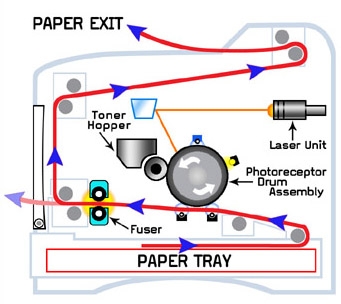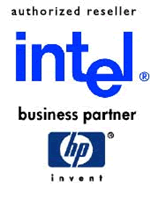
 |
 |
Fireball PC is Proud to be an American Owned and Operated company. |
|||||||||||||||||||||||||||
|
|
|||||||||||||||||||||||||||

|
|||||||||
 |
Laser printers use dry ink, called toner, static electricity, and heat to place and bond the ink onto the paper. The central essential element of the laser printer is a small rotating drum with a coating which allows it to hold an electrostatic charge. First the drum is given a total positive charge. Then a laser beam scans across the surface of the drum, having been told by a PC where to place points of negative charge onto the drum's surface that correspond to the image that is to be printed. The positively charged area of the drum is the same as that of the paper onto which the image will eventually appear, so every point on the drum corresponds to a point on the sheet of paper. In the meantime, the paper is passed through an electrically charged wire that deposits a negative charge onto it. | |
| On laser printers, the selective charging is done by turning the laser on and off as it scans the rotating drum, using a complex arrangement of spinning mirrors and lenses. In a laser printer, the mirror drum spins incredibly quickly and is synchronised with the laser switching on and off. A typical laser printer will perform millions of switches, on and off, every second. Inside the printer, the drum rotates to build one horizontal line at a time. The smaller the rotation, the higher the resolution down the page - the step rotation on a modern laser printer is typically 1/600th of an inch, giving a 600 dots per inch (dpi) vertical resolution rating. Similarly, the faster the laser beam is switched on and off, the higher the resolution across the page. As the drum rotates to allow the next area to receive the laser treatment, the written-on area moves into the laser toner. Toner, sometimes called dry ink, is very fine black powder, positively charged so that it will be attracted to the points of negative charge on the drum surface. Thus, after a full rotation the drum's surface contains the whole of the required black image. A sheet of paper now comes into contact with the drum, fed in by a set of rubber rollers. Before the paper rolls under the drum, it is given a negative charge by the transfer corona wire or a charged roller. This charge is stronger than the negative charge of the electrostatic image on the drum, so the paper can pull the toner powder away. Since it is moving at the same speed as the drum, the paper picks up the image pattern exactly. To keep the paper from clinging to the drum, its charge is removed by the detac corona wire immediately after picking up the toner. As the paper completes its rotation it lifts the toner from the drum, thereby transferring the image to the paper. The areas of the drum still holding the positive charge don't attract toner and result in white areas on the paper. The toner which is now on the paper is specially designed to melt very quickly and a fusing system now applies heat and pressure to the imaged paper in order to adhere the toner permanently. One of the ingredients in the toner is wax, which makes it easier to melt in the fusion process, while it's the heated fusing rollers that cause the paper to emerge from a laser printer warm to the touch. The final stage in the printing process is to clean the drum of any remnants of toner so that it can start the cycle again. This is done in two ways--physical and electrical. In the physical cleaning, toner which was not transferred to the paper is mechanically scraped off the drum by a felt pad and the waste toner collected in a bin. Electrical cleaning takes the form of covering the drum with an even electrical charge by an electrical element called the corona wire so the laser can write on it again. Both the felt pad and the corona wire need to be changed regularly. Color lasersLaser printing technology has been adapted to print colour by using combinations of cyan, magenta and yellow to produce the different printable colours. Four passes through the electro-photographic process as described above take place, to fix the different toners on the page one at a time; or to build up the four-colour image on an intermediate transfer surface. Most modern laser printers have a native resolution of 600 or 1200dpi. Lower resolution models can be found, but they deliver coarser multi-level toner dots resulting in mixed continuous tone and halftone printing, rather than complete continuous tone output. Color laser print speeds vary between 3 and 5ppm in colour and 12 to 14ppm in monochrome. Apart from their speed, which is faster than inkjet printers, one of the main advantages of colour lasers is the durability of their output - their chemically inert toners are fused onto the paper's surface rather than absorbed into it, as with most inkjet printers. This allows colour lasers to print well on a variety of media, without the problems of smudging and fading that can be seen with many inkjets. Furthermore, by controlling the amount of heat and pressure in the fusing process, output can be given a user-controllable "finish", from matte through to gloss. |
||
Article Courtesy of © 2007 Oki Data Systems Inc.
![]()
![]()
![]()
![]()
![]()
![]()
![]()
![]()
![]()
![]()
![]()
![]()
![]()
![]()
![]()
![]()
![]()
![]()
|
Info: Spyware, Virus and Trojan |
| How to Setup Email in Outlook Express Onsite Service Coverage Area |
| Protect Your PC from Spyware & Adware Common Computer Problems |
| Printer and Imaging Resource Center Other Website Links |
| Home l Support l About Us l Affiliates l Contact Us l Privacy l Site Map l Resources l Legal l Valet Computer Upgrade Service l Website Links |
|
© 2007 Fireball PC. All
rights reserved. |












